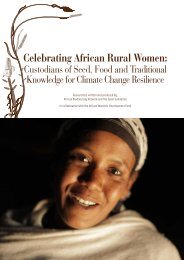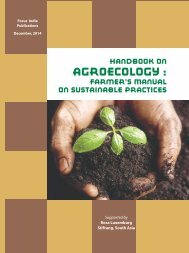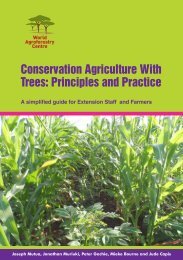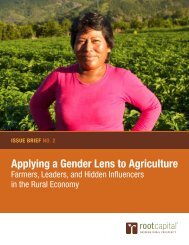1t0SC7l
1t0SC7l
1t0SC7l
You also want an ePaper? Increase the reach of your titles
YUMPU automatically turns print PDFs into web optimized ePapers that Google loves.
1 INTRODUCTION<br />
Between 1995 and 1997, a study on agricultural systems practised by the Bantu population was<br />
conducted in the research area of the Tropenbos-Cameroon Programme (TCP). The TCP<br />
research area is about 180 000 ha in size, and located 70 km East of Kribi between the villages<br />
Bipindi and Akom II (Figure 1.1). The study was to provide a comprehensive description on the<br />
farming systems applied in the TCP research area, with emphasis on shifting cultivation /<br />
natural fallow systems, and insight in soil (fertility) degradation related to such agricultural<br />
practices. Trends and relationships between agricultural field expansion, soil degradation, crop<br />
yields, fallow and population pressure were to be determined, this should lead to<br />
recommendations for sustainable forest land use.<br />
1.1 BACKGROUND AND JUSTIFICATION<br />
The objective of the Tropenbos-Cameroon Programme is to develop methods and strategies for<br />
natural forest management directed at sustainable production of timber and other products and<br />
services. These methods have to be ecologically sound, socially acceptable, technically feasible<br />
and economically viable, and to take other functions of the forest into consideration.<br />
Shifting cultivation is the dominant farming systems component practised in the tropical forest<br />
zone of Cameroon. Although a good deal of publications exist on shifting cultivation in other<br />
areas of the world, and although shifting cultivation has been described for semi-humid areas in<br />
Cameroon, information on this type of land use in the moist evergreen forest of south Cameroon<br />
is scarce.<br />
Although the Tropical Forestry Action Plan (MINAGRI, 1989) did not foresee a significant<br />
agricultural pressure on forest land in southern Cameroon, a Rapid Rural Appraisal conducted<br />
during TCP’s formulation phase revealed that present trends in these agricultural practices,<br />
under increasing influence of market economy as result of local infrastructure development<br />
(rural electrification and road construction), may well lead to expansion of agricultural land in<br />
the near future (Foahom and Jonkers, 1992).<br />
The TCP programme formulation team came to the conclusion that in order to achieve<br />
sustainability of forest production in the forest zone, sustainability of crop production must be<br />
studied conjointly, since shifting cultivation may represent a greater threat to forest than timber<br />
harvesting.<br />
1.2 OBJECTIVES OF THE STUDY<br />
1.2.1 General objective<br />
To reduce destructive effects of shifting cultivation on the forest by proposing to farmers<br />
complementary and / or alternative sedentary practices and by providing information to be<br />
utilised for the sustainable forest land use in southern Cameroon.<br />
1.2.2 Specific objectives<br />
1) To gain understanding of the farming systems practices in the evergreen forest of<br />
Cameroon, the problems, constraints and opportunities related to forest conservation and<br />
agricultural production.<br />
2) To obtain insight in aspects of soil degradation under smallholders’ agricultural land use<br />
systems applied in the evergreen forest of Cameroon.<br />
3) To find trends and relationships between field expansion, soil degradation, crop yield, and<br />
population pressure.<br />
1








